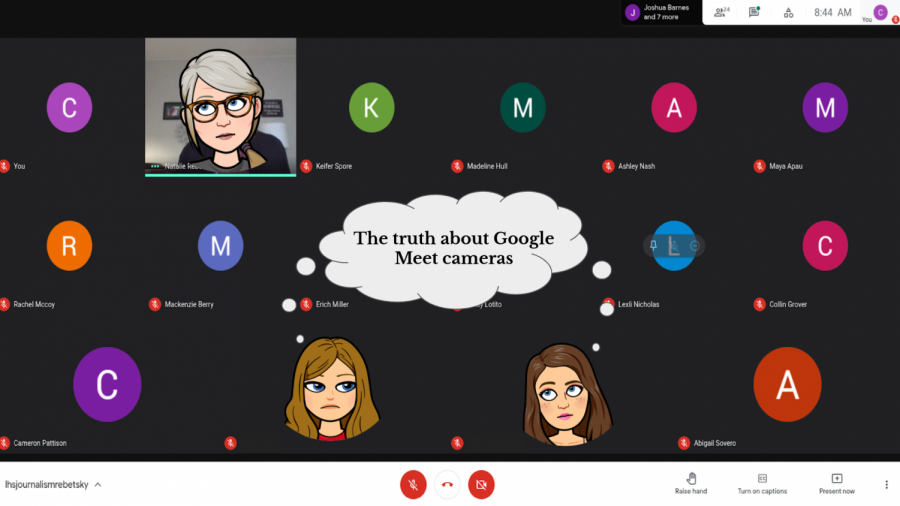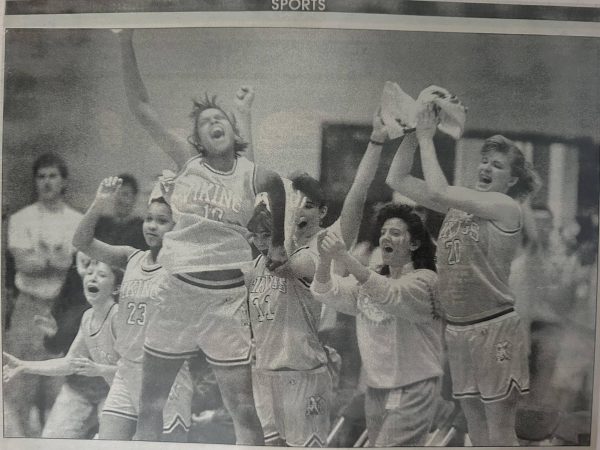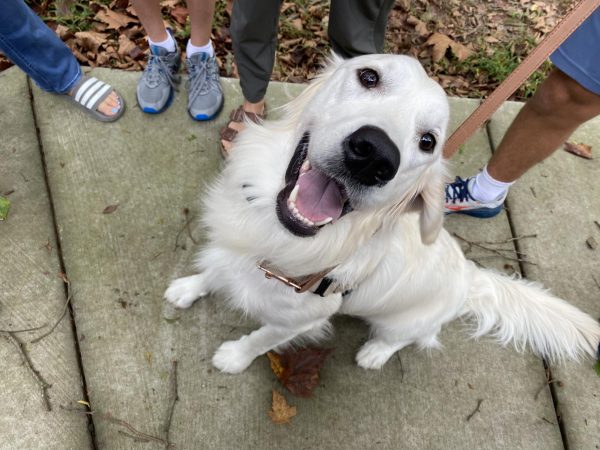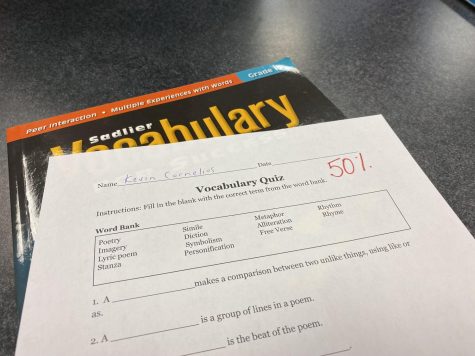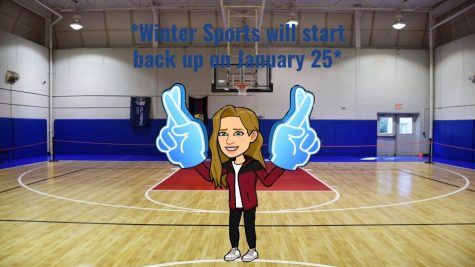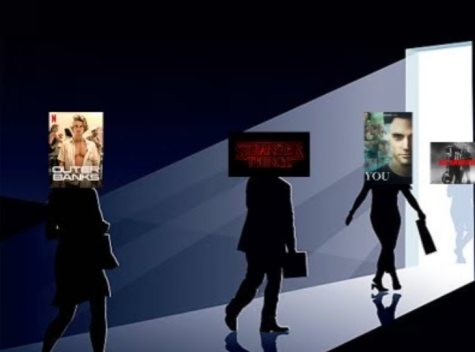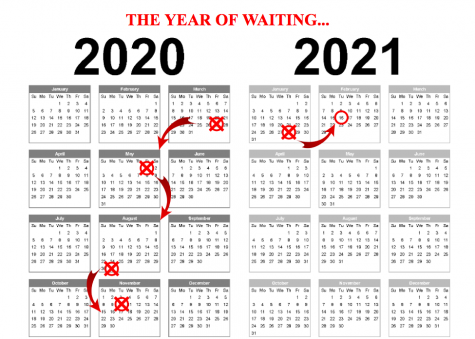Skittles on and cameras off: Not the sweetest choice for teachers
Something as small as seeing another face really brightens teachers’ days.
Journalism teacher Mrs. Rebetsky shows students what a typical google meet looks like through her screen.
On a typical virtual school day, students roll out of bed just in time for their first 8:30 class. These online classes are filled with lectures, notes and breakout rooms. They are greeted by teachers and lesson plans, but little to no friendly faces in the “classroom.”
Many students opt out of having their cameras on for online school, and instead face bubbles to talk to rather than actual faces. Teachers sit talking to nameless bubbles on the daily, often not knowing if the information is getting to each individual. While many students are listening and working, others are napping or multi-tasking.
Jennifer Weiss, a multi level math teacher experiences this disconnect. She refers to the colored bubbles as “Skittles.” She loves when students have cameras on but also respects those who prefer not to. Weiss says she refers to her students as Skittles to try and put a smile on their faces during these uncertain times.
“I understand that some (many) do not want to show their faces; however, as a teacher who watches body language and facial expressions, it’s tough. I have had to learn a whole new ‘wait time’ for the virtual setting.”
Teachers have had to re-create lesson plans to fit virtual lessons, and just make sure students have what they need (without actually seeing them on the Meet).
Weiss says she compensates by being over-prepared for class and just wants to help students as much as possible.
“My workload in classes now is far, far more and strenuous. I try to be over prepared and overly organized for my students. I want everything to be clear as possible and streamlined for my students as well. I would normally do this, but it’s harder when I can’t see them physically, said Weiss.
Beth Ericsson, an AP Biology teacher has also reformatted many of her lesson plans to fit the virtual world. She talks with students regularly about the speed and intensity at which she is teaching the class.
“We are all in a difficult situation, and it is much harder on some of us than it is on others. And it’s still hard on everyone! In class I try to be considerate of this by having my class help me plan a schedule that works for us all in terms of due dates and testing, whenever possible. When students let me know that they are unable to complete something by a previously agreed upon date, I hear them. I don’t judge,” said Ericsson.
Teachers often run into “no camera sadness” when they go onto Google Meets. Instead of students’ faces, they are presented with icons, bubbles.
Spanish teacher Jake Snow has been talking to these bubbles for the majority of his teaching in quarantine. He is a multi level Spanish teacher who ordinarily relies on face to face connection to teach.
Snow said, “It’s kind of awkward and depressing . . . sitting in the same spot…icons only showing the first letter of their (students) first name.”
This no camera sadness also has effects on the speed and difficulty of the class overall. Teachers cannot see how a student is reacting to the lesson, the visual facial cues of confusion, or when a student needs help if their camera is off.
“It makes it much harder to tell if a student is struggling–I am a very visual person. However, I have asked poll questions, asked students to come in support hours, done quick Schoology checks to see how the student is comprehending the content. I try to communicate as much as possible so everyone feels comfortable approaching me with questions,” said Weiss.
“I tend to be generous and forgiving with due dates because you just never know what a student is dealing with and how much an assignment might be adding to the stress,” said Ericsson.
The students who do have their cameras on are making an impact, whether they know it or not. It makes every teacher feel better, especially when they have 60-80 students.
“The students that notice how hard I work and express appreciation for it mean more to me than those students can possibly realize. It makes it all worthwhile. Some days those positive messages are the only thing that keep me going. Negative comments about the fact that we’re in school virtually tend to sting, like it’s the teachers’ fault. What will get us back into school is if we all follow the guidelines– please practice social distancing, wear a mask and wash your hands a ridiculous number of times!” said Ericsson.
Fear of cameras
It is difficult for teachers to develop relationships with students when they cannot put a name to a face. However this does not excuse the students’ feelings about the anxiety and stress they are already facing with online learning.
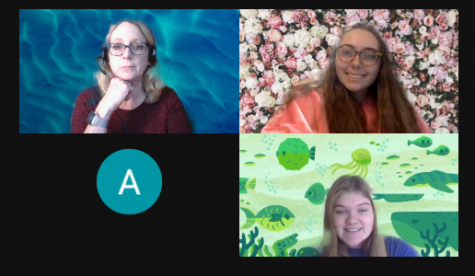
Ericsson is appreciative of all the students she can see but also empathizes with those who choose not to have their camera on.
“I totally understand not wanting to turn the camera on. Some days I am so critical of how I look. I feel like kids can see my every wrinkle and can count my grey hairs. I feel scrutinized. So I put myself in a little box in the corner of the screen that I can barely see me; then I don’t agonize over how I look. I know how hard it can be for young people to feel they are being scrutinized by their peers. We’re not typically looking at each other’s faces in school all day. It’s all so weird,” said Ericsson.
Also, it can be difficult for many students to turn on their microphones and speak up in class. Some are too nervous to speak up when they are confused or need help; others feel like they just aren’t being heard with the chaos of the live video. Some only type in the chat, where their responses are seen and not heard.
Daniela Gerardi, a junior, shares her experiences with Google Meet cameras.
“It depends on the class when my camera is on. It’s all about feeling comfortable. If you are the only one who has your camera on in class, you almost feel singled out. If you feel comfortable with the teacher and your peers, it can be really easy to leave your camera on,” said Gerardi.
With people having to speak one at a time on Google Meet, it just amplifies the fear that many students previously had.
“It is hard to ask for help because of the possibility of interrupting your teacher. The question might not pertain to all students, so it could be hard to ask it. You want to be as respectful as possible, but oftentimes we have to interrupt when we have questions,” said Gerardi.
Normally in a live, in-person classroom, students are working on a variety of tasks: they are talking in small groups or focusing on their work. This gives the teacher more time to focus on the students who are struggling, and lets the students ask questions one on one. Now with Google Meet, students ask questions in front of the whole class, and have fears of being judged.
Mary Bailey, a junior, has faced this challenge many times in her virtual classroom.
“It is definitely hard for me to ask for help with virtual school. I feel like when we’re in school it’s a whole different situation and other students are asking questions as well, but online it’s silent most of the time and there is a sense of awkwardness when no one is talking. Not having cameras on just amplifies that awkwardness,” said Bailey.
There isn’t much social interaction, and it is hard to have a bond with teachers. Students rely on the friends they already have in the class, rather than making new ones. It is almost impossible to talk one to one with a person if you aren’t in a breakout room with them. This just adds to the level of discomfort students face, not knowing the peers in the class and not being able to put a name to a face.
This change has been especially hard on students who have enrolled from other schools and on freshmen. New students came into this school year already having limited contact with other students; now they can’t even identify their peers because of the lack of face to face interaction.
Inviting people in
Not only do students feel isolated when they need help, most students feel uncomfortable having teachers and peers take a look at what their personal life may look like. They may feel anxious to turn on their cameras to reveal a messy room or feel uncomfortable having others see into their homes and work spaces.
Mt. St. Mary’s student teacher Sharon Jones has been popping into Google Meets and loves to talk to the students and teachers in the Lancer community.
Both teachers and students have very mixed feelings about cameras. During the first term, some teachers thought of using the cameras as a participation grade for the class. A good idea, in theory, but is that fair?
What if a person’s camera doesn’t work? What if they are uncomfortable turning it on for the whole 80-minute time period?
It is best to leave cameras up as an option to create a more relaxed environment in the classroom. If a student feels uncomfortable/obligated to show their learning space, it may create a tension between student and teacher.
Junior Olivia Fullarton feels more comfortable turning on her camera.
“I normally turn on my camera. I want teachers to know that I’m listening and learning through the lesson. I feel bad when they are staring at blank screens,” said Fullarton.
Similar to other students, Mary Bailey feels that turning on the camera helps both her and the teacher in the class.
“I do turn on my camera most of the time, mostly because I don’t want teachers to stare at a blank screen while teaching…I feel that it makes them more comfortable as well,” said Bailey.
During class a family member, friend, or pet could be in the frame, and students just might feel uncomfortable showing them to the class. Being “in” class does not eliminate the busy home life that every student faces, so it is most times for good reason why students neglect the camera option for school.
Spanish teacher Snow has been in and out of the school building to teach, but when he’s at home with his cat, his students get to see and hear his cat.
Snow said, “Half the time my cat is coming in and out of the Google Meets.”
There are many distractions that could be embarrassing if the camera is left on. Sometimes a student has to turn it off to talk to a family member or move to a different room. Flexibility is key when it comes to having cameras on.
Every teacher also offers one to one student enrichment time, or office hours for extra help. This is a valuable time that every student should take advantage of.
Journalism teacher, Mrs. Rebetsky offers office hours every day to her students and is always there to help.
Teachers are working to build new relationships with students during these times.
“It’s harder to build relationships when you’re not in the same room, but I have tried my best to build relationships with my students in our virtual classroom. We all can only do the best we can do. As my mom used to say, ‘it is what it is’,” said Ericsson.
Virtual Connection issues
There are many other issues that could cause camera troubles such as poor WiFi connection, slow internet, or being unable to access the course material at the same time as the Meet. Sometimes platforms such as Schoology or Google Meet completely shut down, making it much more difficult for students to successfully learn and attend.
It is important to take in all considerations of what a student’s life might be.
“I hope my students know that I can always be leaned on. I am always available to listen. This isn’t something that can be forced. It is a mutually trusting relationship that can only be built,” said Ericsson.
Your donation will support the student journalists of Linganore High School. Your contribution will allow us to purchase camera/recording equipment and software. We hope to raise enough money to re-start a monthly printed issue of our paper.



